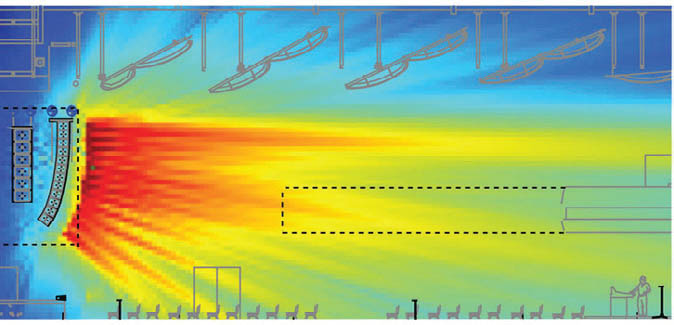Audio prediction software has been around for quite a while. Starting as primitive, CPU-hungry programs that only showed monochrome gradients of loudspeaker coverage, most manufacturers now offer products that can render 3D predictions on most laptops and churn out beautiful rainbows of coverage patterns. Oh, and they’re usually free.
The benefit of using these programs, particularly on larger shows, is well understood. Large line arrays with numerous inter-box angles and multiple rigging points need that pre-production planning so that when system engineers go into a venue, they know exactly what they’re getting into. The local hands aren’t going to stand around waiting for a system engineer to have a listen and then tell them to re-pin the boxes.
But often I hear people say, “I don’t need prediction, it’s a small show.” And yes, while maybe you aren’t flying dozens of array elements per hang and rigging literal tons of loudspeakers in the air, knowing where to place those loudspeakers before you even set foot into a venue will save valuable time.
Ahead Of The Game
First, let’s start with the obvious: Did you bring enough gear? Or maybe too much? Prediction facilitates better planning on what equipment is brought to a gig. Let’s say you didn’t do any prediction and upon arriving at the venue, you immediately notice there’s a gap in coverage. Perhaps a delay loudspeaker is needed or maybe an out-fill or an in-fill – but oh no – there’s nothing left on the truck!
This means either a time-consuming trip back to the shop or dealing with that gap in coverage with what’s available on site. A prediction likely would have revealed the gap in coverage, indicating that the need for that extra loudspeaker (or two) would have been known literally before ever packing a case.
The same goes for cables and accessories. Assessing the right amount of cable, amplification, stands, and other accessories is something that should be known before you’re standing on location. And if you didn’t know about that delay loudspeaker needing to be located out yonder, then maybe you also didn’t pack enough cable to get to it.
The reverse is also true. Perhaps there’s an event you’ve done many times but never ran a prediction. Go ahead, put the parameters into the prediction software, and you may just find that you can attain as good or better result with less loudspeakers (and perhaps other gear) than in the past.
It also provides an opportunity to evaluate other loudspeakers in the inventory – what if something else in the shop could do a better job but has never been tried because you’ve been doing this event the same way for a while and didn’t want to risk something new on a repeat client? Well, go ahead and check it virtually without ever having to take the gear to the venue.
Virtual To Reality
Another advantage of prediction is confirming theoretical loudspeaker response with that of the real world. I’ve been brand agnostic to this point, but for the moment I’ll use the Meyer Sound MAPP platform in an example since it’s what I use most frequently. – it’s a safe bet that other manufacturers’ software can do this as well, but MAPP is what I know best.
Anyway, in MAPP you can insert a microphone into a virtual venue and then export a measurement trace, which can then be entered in a dual-channel FFT (fast Fourier transform) program of choice. This trace can be used for two things: to confirm tonal balance and to serve as a target trace.
First, this trace can be employed to see what the software said it should sound like and compare that with what it actually sounds like. I use it as a confirmation that things are headed in the right direction (or not). While it’s not 100 percent accurate due to the trace from MAPP being created in a “virtual room” without reflections rather than in a room in the real world, it’s usually close enough to reveal any significant problems.
Figure 1 shows magnitude data from an indoor event I worked about a year ago. The green trace represents the exported data from my prediction, the purple trace is a microphone placed roughly in the same spot that I’d measured from in my predition, and the orange trace is an average of many real-world mic measurements throughout the venue. What this tells me is that everything is as expected; it’s what the prediction said it would be and any minor variations are likely due to some factor other than a poorly deployed PA.

In addition, this virtual trace can be used as a target EQ for the real-world system. When I design systems virtually, I’m striving for consistency both in level and tonality. So whatever trace is provided by MAPP is usually what
I’m aiming for that show and in that specific spot in the venue.
Prediction is a very important tool in the system tech workbox. The ability to accurately know how to deploy a bespoke system, no matter the size and before even packing a case, is a great option to have available.
So, whether you’re flying an arena PA or popping portable loudspeakers on sticks for an elementary school theatre production, the use of prediction software in pre-production helps guarantee speed and accuracy on site. Besides, what have you got to lose? The software is free and there’s no reason not to download it from whatever manufacturer’s gear you happen to work with most often.















